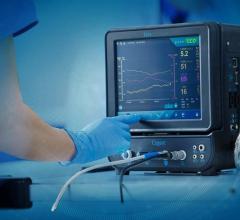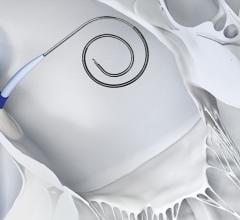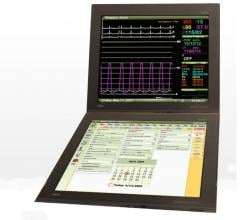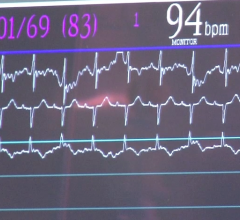
Carroll Hospital cath lab staff (left to right) Gina Stanley, RTR David Zimrin, M.D. Tony Pinson, RTRCV Cole Boone, RTRCV and Ashley Patchak, RTR.
Tony Pinson, RTRCV, has worked at Carroll Hospital Center in Westminster, Md., for nearly 20 years. During that time, the cardiac catheterization laboratory supervisor has witnessed drastic changes at the private, nonprofit, 213-bed hospital that prides itself on providing exceptional care for patients in Carroll and surrounding counties. One of the most monumental changes, he says, came in May 2009 when the hospital implemented new technology to add efficiency in the cardiovascular lab.
Wanting to discard paper-based systems in its cath lab, Carroll Hospital Center implemented an integrated cardiovascular information solution (CVIS) that connects the continuum of care – before, during and after cardiovascular procedures – and stores all images and information in one central database so that clinicians have the patient’s entire clinical data at their fingertips. Since implementing the integrated cath lab (ICL) system of McKesson’s Horizon Cardiology CVIS, Pinson’s department has significantly improved documentation and added capacity by reducing procedure room turnaround time by approximately 70 percent.
The Challenge
In any hospital, the amount of information generated for each cardiac patient is immense and valuable. That information is gathered from multiple points — the holding area, the cath lab and the recovery room. Most systems on the market have separate databases and simply interface between the three care areas, creating not only a technological challenge, but also a clinical challenge because data and precious time are often lost.
“Our existing hemodynamic system was becoming antiquated compared to new solutions emerging in the market,” recalls Pinson. “Much of our documentation had to be handwritten. This was time-consuming for both our staff and our physicians. We knew we had to implement a system that would help us keep pace with our increasing volumes and help us to maintain quality and improve efficiency.” “Our old technology didn’t afford us the ability to implement innovative data management,” says Kim Whittaker, Carroll Hospital Center’s senior systems application analyst and project manager for cardiology systems. “We were working out of several systems, none of which worked together. It just wouldn’t allow us to streamline data, a key component to any clinical process.”
The Answer
When Carroll Hospital Center began evaluating new systems, integration became the key driver. The hospital had already implemented the McKesson Radiology Manager radiology information system (RIS) and McKesson’s Horizon Medical Imaging picture archiving and communications system (PACS). Together, the systems had begun to improve the administrative and clinical workflow of its imaging department. Following in the footsteps of radiology, the cath lab team determined that optimizing workflow was the key to improving operations. Therefore, they wanted to select a CVIS system that best matched the workflow of the cardiovascular department. The unique ICL offering in Horizon Cardiology provided the answer with a single-system solution that connects – in real time – all stages of the hospital’s cardiovascular workflow, including image management, hemodynamic monitoring, procedure reporting and archiving.
“Horizon Cardiology offered more than other systems,” explains Sharon Sanders, RN, BSN, MBA, Carroll Hospital Center’s executive director of cardiovascular services. “Instead of having to pull data from different systems, it seamlessly flows from beginning to end. Because all data resides in one database, when it’s entered in hemo, it is instantly available from any workstation.”
At Carroll Hospital Center, 20 cardiologists and surgeons use the system. Now, instead of having to find films, they can simultaneously view all of the patient’s cardiovascular images electronically while reporting on the procedure, even while the patient is still on the table. Physicians also now have remote access so they can view and edit the report from home or their offices.
“Everyone fell in love with the system, and today our cardiovascular lab is totally electronic,” says Whittaker. “Without having to worry about a paper chart, cardiologists, nurses and cath lab staff feel they are able to deliver more personalized and efficient care.”
The Results
By creating efficiencies in the documentation steps, Sanders says the cath lab was able to add volume without adding staff. The procedure room turnaround time was reduced from 35 minutes to 10 minutes, allowing an extra procedure to be added each day. Additionally, she is running three rooms with the staff she used to need for two rooms because there is no longer a need for manual documentation. The single repository of data has significantly improved access and efficiency such that Pinson, who used to spend a great deal of time manually collecting data, says the cardiologists are finishing their reports before he’s ready for them.
This case study was supplied by McKesson.
For more information: www.allaboutcvis.com




 November 14, 2023
November 14, 2023 





